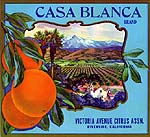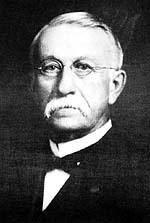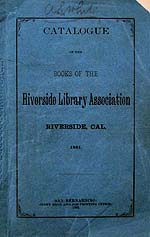
Historical Scrapbook:
RIVERSIDE LIBRARIES 1873-1903
The Riverside Library Association 1879-1888
The Constitution and By-Laws of the Riverside Library Association
(link will open PDF file).
Images courtesy of Riverside Public Library..
Catalogue of books of the Library Association, 1881.
(link will open PDF file of 1883 supplement to the catalogue)
Images courtesy of Riverside Public Library.
As soon as Judge John W. North finished his house on Vine Street, he declared his parlor a community reading room and opened his books to the public. By the 1873, settlers donated more books to the collection and arranged for space in new schoolhouse on Sixth Street. James H. Roe noted in his Riverside chronicle “… the number of volumes was small, but there were some very interesting books among them” (p. 12). A library committee was organized to take care of lending, but the library did not have any arrangements for funding or paid staff (Baker 1988, p. 1). Even though in 1875 Roe noted “Riverside … began to be noted among the surrounding towns as a place where everybody had a piano and a top buggy” (Roe, p. 30) indicating prosperous community, the library languished.
The fact was that even without a proper library, residents of Riverside did not lack for reading material. The first Riverside’s newspaper – The Riverside News – appeared on November 27, 1875 (Roe, p. 19) and after its demise, there was always at least one daily or weekly paper published in Riverside. Together with the newspapers from Los Angeles or San Francisco arriving by the post, they provided for ample and entertaining reading. Marie Leibert Goethals (1970), in her recollections of childhood and school time in Arlington Heights (part of Riverside along Victoria Avenue) at the turn of the century, she wrote:
… A man was making the rounds locally, trying to sell subscriptions to a weekly San Francisco paper. The Chronicle was putting out a large edition on Thursdays, which was sent throughout the state with delivery guaranteed on Saturday… This man asked me to read parts of the children's page so that my father might see that the very young could benefit from its pages… With that interesting paper teaching me reading each week, I dismissed the school library from my thoughts. I might be exaggerating if I say that I entered that library only a half a dozen times, but then it is possible that the doors weren't open any more often than that (p. 14).
In defense of newspaper reading, one my note that Marie went on to graduate from University of California in Berkeley and later become well-respected teacher in Riverside school district.
It was not until 1879, that the former newspaperman Elmer W. Holmes and businessmen Albert S. White, decided to organize a subscription library. Roe, also a member of the newly formed library committee, noted in his chronicle:
“In June [1879], a public library association was formed through the active efforts of Mr. A. E. White and Mr. E. W. Holmes. A committee to select books to the extent of $300 was selected, consisting of Messrs. White, Haskell, Wright, Holmes, and Roe. Dr. C. J. Gill was made president and the drugstore of Roe & Co. selected as the place for the library. A dramatic entertainment organized by E. W. Holmes furnished one half of the fund expended” (p. 32).
The books were ordered from Bancroft Book Co. from San Francisco through their local salesman A. H. Mertes (Baker 1988, p. 2). Collecting pledged donations was not a smooth sailing if it is judged from the repeated appeals for payment of dues in Roe’s newspaper. In order to collect $300 necessary to pay for books, Albert White in particular prove himself a creative fundraiser staging a theater plays as a benefit drives. The establishment of a drama club was an unexpected side effect of these efforts and White later became, among other things, a director of the Loring Opera House Company. Eventually, the books were paid for and arrived in Riverside on July 5, 1879. Soon afterwards, Roe printed a book catalog—a list two hundred titles long (Baker 1988, p. 3).
Any citizen of Riverside could become a member of the Association “upon the payment of three dollars, subscribing to the Constitution and By-Laws, and paying a quarterly fee of fifty cents.” (The Library Association By-Laws 1879, p. 7) A member could borrow a book for three weeks. If book was overdue, a fine of two cents per day was charged. Although it eventually accumulated, through purchase or donation, a thousand books, the Association was continuously plagued with financial difficulties. In 1883 Catalogue supplement, the Library Trustees announced that “for the sake of popularizing the institution” (p. 1) the price of membership was lowered to $2 dollars and members were allowed to take home two books at the time. They also emphasized that “no institutions of this kind can prosper without money” (p. 1) and begged members to be prompt in payment of their obligations.
In the late 1880s, Riverside, and in extension the Library Association, started to prosper from the booming citrus industry. During 1882, Roe resigned his position and the Association contracted with John W. Hamilton to continue the library service from his drug store (Baker 1988, p. 4). However, to judge from the advertisements published in local newspapers, Hamilton was not as enthusiastic librarian as James Roe was. While Roe advertised library services prominently, assuring that the “library is open day and night,” Hamilton’s ads simply state that his store is a “depository of public library.”
Hamilton’s librarianship was cut short by the fire, which on October 12, 1884 burned down most of the commercial buildings on the Main and Eight street (Baker 1988, p. 4). According to Roe, Hamilton’s “drug stock was badly injured from being turned into the street” (p. 55). Miraculously, or rather, through the efforts of the citizens of Riverside, most of the book collection was saved. In 1886, Hamilton was forced to vacate the premises and the whole Eight street storefront was leveled down and rebuild in brick.
By then, it become clear that the book collection was too large to be managed as the side business in a general store, but the Association lacked the finances to address the issue. They boxed their books and stored them around the town to wait for better times (Baker 1988, p. 5). For a while, Hamilton resumed his business in the new storefront on Main Street, but in 1888, he sold his business to F. M. Heath, a new arrival from New York State (Riverside Press Annual 1889-90, p. 31)
This temporary setback did not discourage Elmer Holmes and Albert White in the matter of a public library. In the ten years that the Association operated, things in the city and state of California changed that opened new options for the library organization. In 1883, the Riverside colony becomes incorporated into the City of Riverside “partly that the liquor traffic might be regulated and partly that the fixing of water rates should be in the hands of the people who used the water” (Roe, p. 49). And partly, Holmes and White probably reasoned, so that truly public library could be organized. In the 1880s, public, tax-supported libraries were well-established institutions in big towns like Boston (the first ever tax-supported library, established in 1852) or Chicago (1872) and towns on the West were in increasing numbers following their examples.
Text, design, and digital imaging by Vlasta Radan.
Last update May 4, 2006.




